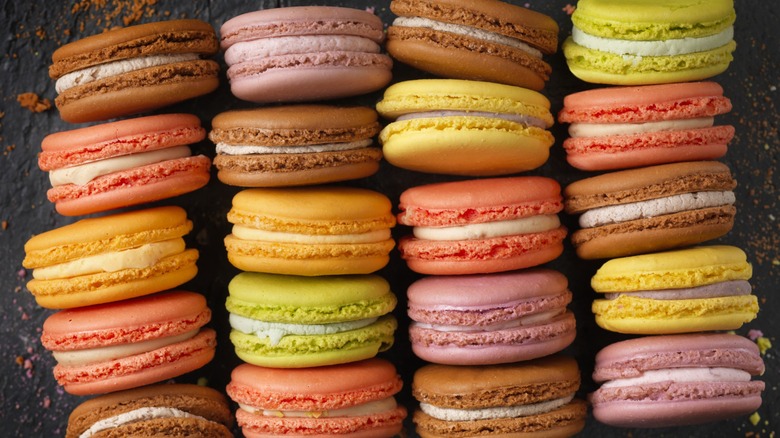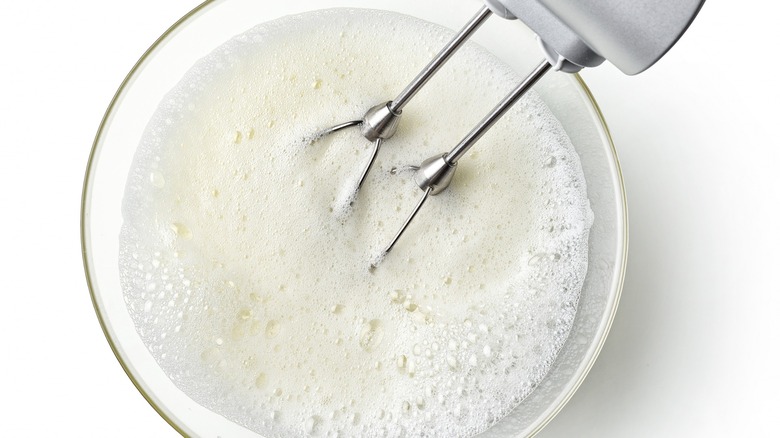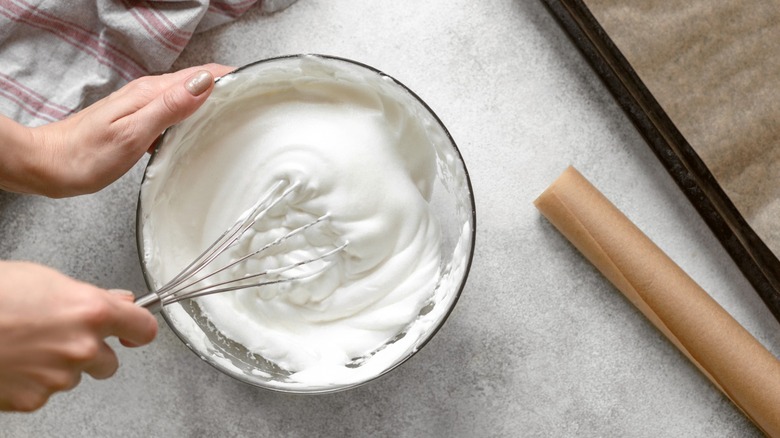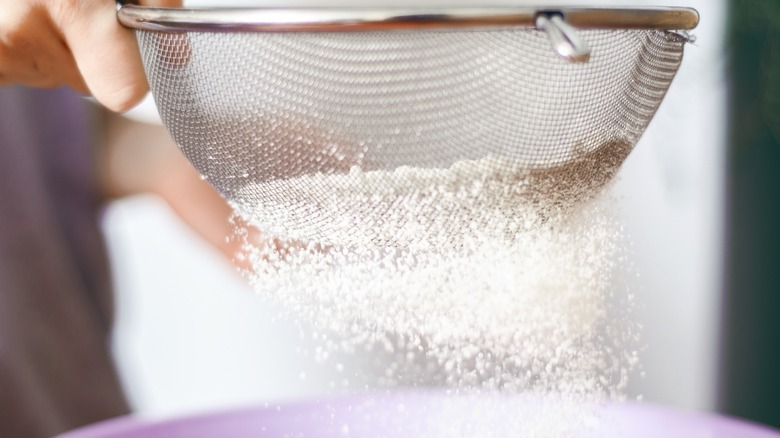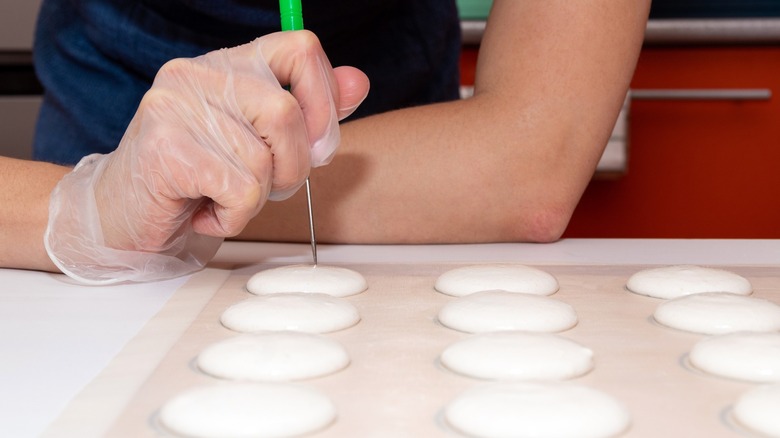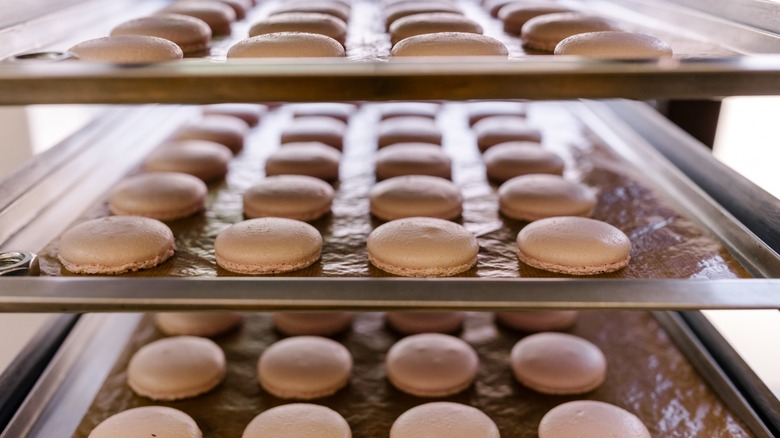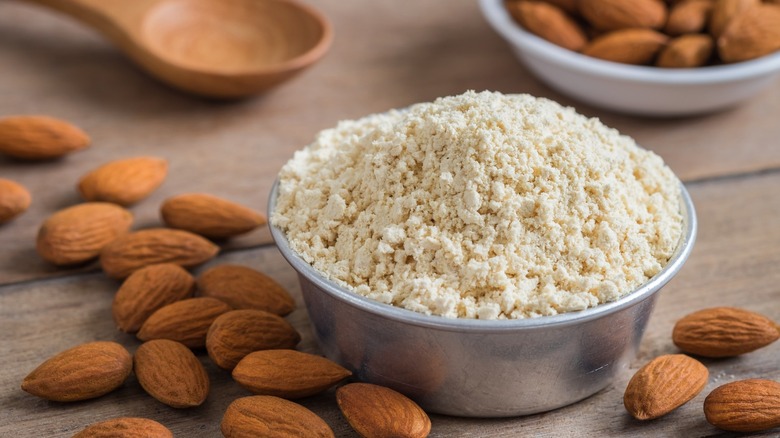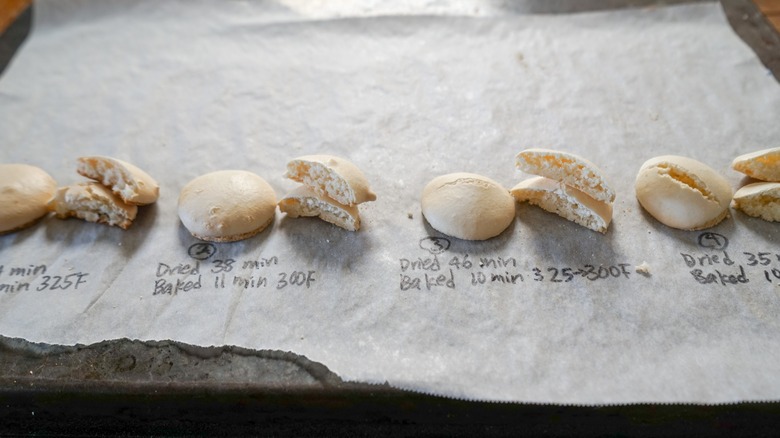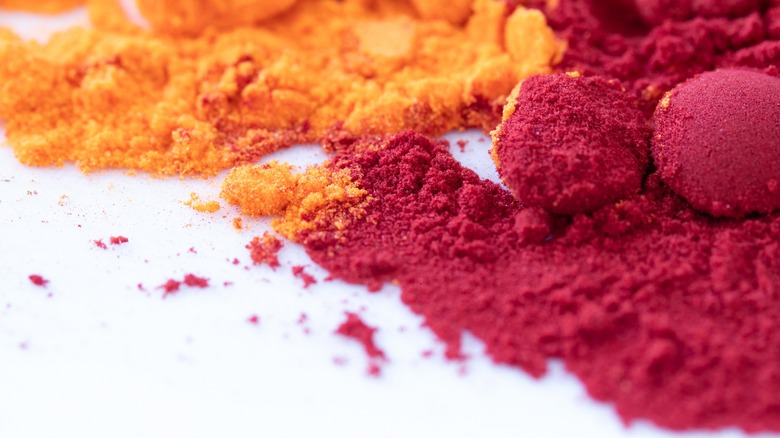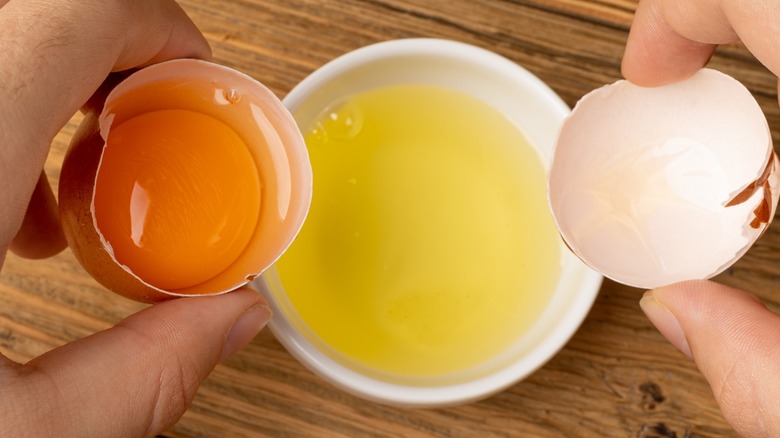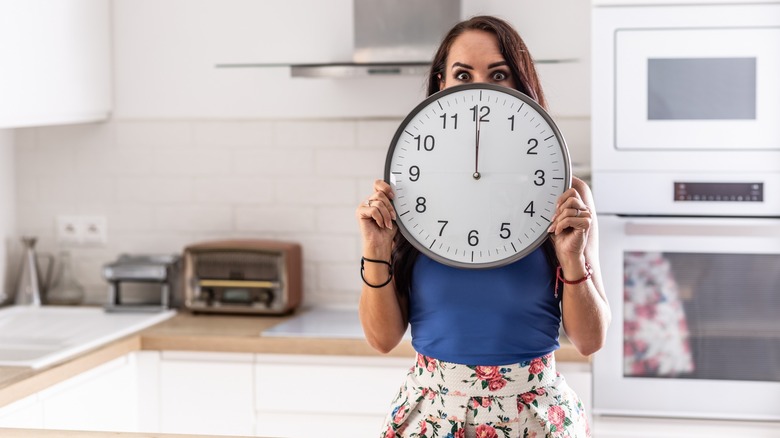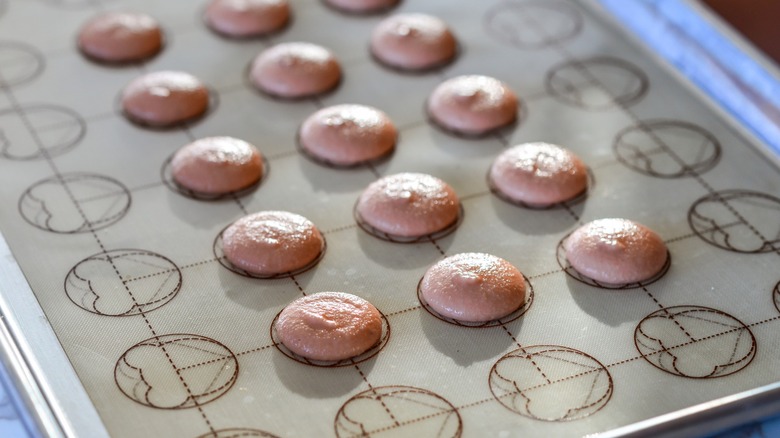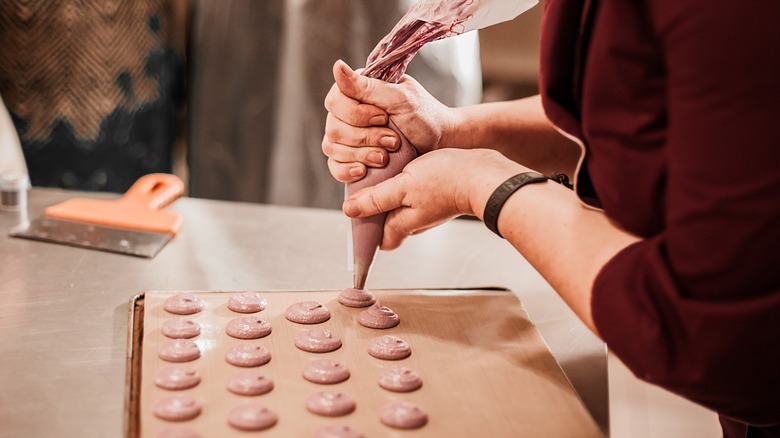13 Common Mistakes To Avoid When Making Macarons
Pretty pastel-colored macarons are some of the most beautiful sweet treats around. You don't need to head for your local French bakery to indulge, though, as this classic French almond treat is something you can make yourself at home. If you've never made macarons before, don't be fooled by the seeming simplicity of the short ingredients list that always includes sugar, egg whites, and almond flour. There's a lot more to know about making your own macarons from scratch — and a lot that can go wrong.
There are a few common mistakes most people are guilty of when trying to make macarons for the first time. We've gathered together 13 of them in one handy list, so we'll show you what not to do, and what to do instead for perfect results. Remember: even the most proficient of home chefs may need to practice their macaron recipe a few times before perfection ensues!
1. Undermixing or overmixing your batter
Mixing your macaron batter might seem simple, but there's a risk of overmixing or undermixing, and both are bad news in the quest for perfect macarons. If you undermix or overmix your batter, your macarons may come out flat, or they could even be hollow, without that delicious chewy interior. So how do you ensure you're getting it just right?
After adding the meringue to the dry ingredients, you should use a technique called "macronage" to fold and mix the batter until it becomes smooth and shiny. This technique ensures the macaron batter is smooth, shiny, and flows off the back of a spoon smoothly. To ensure your batter has reached the right lava-like consistency, use your spatula to pick it up then let it flow into the bowl as you draw the figure 8. You'll need to mix it more if you can't do this, but if the figure 8 forms too fast, you may have overmixed. Don't panic if you can't get this right first time — there's an art to the technique and it takes practice.
2. Making the wrong type of meringue
If you've never made meringue before you may have assumed there's just one type, but there are actually three different types! French meringue involves beating egg whites with granulated sugar. For Swiss meringue, egg whites and sugar are beaten over a double boiler. Finally, Italian meringue, the most stable of the three, swaps out the granulated sugar for hot sugar syrup with a 2:1 ratio of sugar to water.
Most people recommend using Italian meringue for macarons, particularly if you're a beginner. Since it's the most stable, it gives you more time to work with the batter. If you prefer, you can use French meringue. You'll need to ensure that the sugar syrup temperature is as close to 240F as possible and that you add it slowly to the beaten egg whites. Whipping the sugar syrup and egg whites together slightly cooks the whites and gives them a glossy finish.
3. Not sifting your sugar and flour
Chances are if you're a regular baker, you already sift your dry ingredients through a sieve. Not everybody thinks to do this though, and failing to do so is one of the most common mistakes when making macarons. It's important to sieve your dry ingredients to stop any large almond chunks from showing up in your batter. You'll also find this aerates the ingredients for light, fluffy macarons.
To sift your ingredients, you'll need a sieve and a large bowl. Rest the sieve over the bowl and pour in your almond flour, pushing any small lumps through the mesh. Repeat this for the sugar, then mix the two gently with a spoon. It's a good idea to sift your dry ingredients for a second time when adding them to your meringue mixture, to ensure all lumps have been eliminated.
If you skip this step, you may end up with lumps of almond flour in your finished macarons. You might even find that your macarons come out denser than expected if you haven't taken the time to aerate the flour and sugar.
4. Not tapping the pan
Your macarons look great and they're ready to go into a hot oven. Don't forget to drop the pan a few times, though! This technique of tapping the pan before baking the macarons is called "Rappé" in French — meaning "rap" —and helps to release air bubbles from the macarons, preventing them from cracking in the oven.
To do this, lift your tray around six inches above your worktop then drop it a couple of times. This should be done gently to avoid disturbing their shape. You could also use a sterile needle or toothpick to manually remove any air pockets or bubbles you can see on your macarons. This should be done before the resting stage. For the ultimate in air bubble elimination, why not use both techniques? Try manually popping bubbles first, then tap your tray on the counter a couple of times to be certain.
5. Not resting the macarons before baking
You've made your macaron batter perfectly, you've piped perfectly concentric circles onto your baking sheet, your oven is hot, and now you're ready to bake those babies. Hold up! Don't forget that the macarons need to rest after piping, and if you forget to do this, the results could be disastrous.
Failing to rest the batter for an adequate amount of time could lead to your macarons cracking in the oven. When the batter rests, it develops a skin — the longer it rests, the thicker the skin. Macarons with a thin skin could allow heat to burst through when baking, leading to cracked tops. But rest your macarons for too long and all the air will escape from the batter, so they won't rise properly. You might also find they don't develop feet if you don't rest your batter.
Ideally, you should rest your piped macarons for around 40 to 60 minutes. To test if they're oven-ready, press your finger lightly on the surface. It should be dry rather than sticky, and more matte than shiny. If you live in an area with high humidity, you may need to rest your macarons for longer.
6. Substituting another flour for almond flour
As we mentioned earlier, there are only a few ingredients needed for macarons, the most important of which is almond flour. If you have a nut allergy, you might be tempted to swap out the almond flour for all-purpose flour. Don't do this, though, as the consistency for piping will be all wrong and your macarons will end in disaster!
You might also want to swap almond flour for other nut flours, but it's not recommended to do this either. In an interview with Tasting Table, Amanda Schlarbaum, a pastry expert from the King Arthur Baking Company (KABC) Baking Hotline, said, "You can try another nut or experiment with seeds, like pumpkin or sunflower, but it won't produce the traditional macaron in color nor flavor."
While we're on the subject of almond flour, it's important to use blanched almond flour. The blanched variety doesn't contain almond peel, which matters as oil is the enemy of macarons and the natural oils contained in the peel could ruin your recipe.
7. Baking them at too high temperatures
You can't just throw your macarons in the oven on high heat and hope for the best. These little sweet treats need to bake slowly at a low heat to ensure they come out perfectly. That means setting your oven temperature somewhere between 200 F to 300 F and baking them for around 15 to 30 minutes.
Every oven is different and you'll need to experiment to find the perfect timings and temperature for your oven. Don't forget, if you're using a fan oven you'll need to reduce the heat accordingly — most recipes will advise on the ideal temperature to use. Keeping an eye on your macarons is essential too as they can quickly go from perfectly cooked to burnt in a matter of minutes.
Overcooking your macarons at high temperatures could lead to them cracking, which doesn't look great. You might also notice dark spots on the feet which will give the macarons a burnt flavor — not what you're going for.
8. Opting for liquid food coloring
One of the reasons macarons are so popular comes down to their gorgeous eye-catching colors. From lilac to rose pink, mint green to baby blue, colors can be as muted or as vibrant as you like but you'll need to ensure you use the right type of food coloring. Using liquid food coloring is a huge no-no when making macarons, as the moisture in the liquid will ruin the consistency of your batter. This could result in your shells becoming misshapen or failing to bake properly in the oven.
Instead, use powder or gel food coloring to tint your batter to the perfect hue. With gel food coloring you can play around with single-colored macarons, mix shades for a tie-dye effect, or even combine the food coloring with water and splatter it over your cooked macarons for something really unusual.
Powdered food coloring can be mixed into the macaron batter. Another way to apply powder to your macarons is to dust it onto the tops of the shells before baking, for a pretty and subtle effect.
9. Using pre-packaged egg whites
Using pre-packaged egg whites in a carton can be convenient when you're baking, but for a recipe that leans so heavily on egg whites, it's always best to use fresh eggs. A study in Poultry Science published by Science Direct revealed that egg whites in a carton might contain ingredients that can affect the quality of your meringue, such as emulsifiers and stabilizers. Egg whites in cartons are also pasteurized, which can make them harder to whip up for light, fluffy results when baking.
When using fresh eggs, it's important not to use them straight from the fridge. Though you can use fridge-cold eggs for macarons, using room-temperature eggs results in more stable meringue, which means more reliably perfect macarons, so don't forget to take your eggs out of the fridge a while before you plan to begin baking. The fresher the eggs, the better, too, as fresh egg whites will form stiff peaks more easily.
10. Not separating the eggs carefully
It's well worth taking the time to separate your eggs carefully when making macarons. If you rush the process and end up with egg yolk in your whites, you might end up with less fluffy meringue. That's because the fat in the egg yolk could interfere with the protein in the whites, affecting how much your whites fluff up.
If you're struggling to perfectly separate eggs, use an egg separator that you can easily find on Amazon for a few dollars. As for what to do with those leftover egg yolks? You could whip them into a perfect Hollandaise for an Eggs Benedict brunch, make crème brûlée for dessert, add them to mac and cheese for an even creamier sauce, or even make Spaghetti Carbonara — the traditional recipe uses egg yolks in the sauce and leaves out heavy cream; and it's delicious!
11. Rushing the process
It's not just separating eggs that can be time-consuming when making macarons — the whole process of macaron making is one that requires patience. From the sifting of the dry ingredients to beating the egg whites and carefully folding the meringue and dry ingredients together, to piping the macarons and letting them rest, it's best to not rush the process.
Making macarons isn't only time-consuming but it can be a tricky process to master, too. Even if you're usually a baking expert you might find you need to make a few batches of macarons before you get perfect results. Every batch is a learning curve until, eventually, you've mastered the recipe and your macarons turn out perfectly every time. Or almost every time.
From start to finish it can take a good couple of hours or more to prepare macarons from scratch. Once they're baked and filled, some recommend refrigerating them for up to 24 hours before enjoying them at their best.
12. Forgetting to line your pan
When you've finally mastered making macaron batter to the perfect consistency and piping it into little rounds on your baking sheet, there's nothing worse than the macarons sticking to the pan! Don't forget to line it. Parchment paper is the go-to as it absorbs oils and will stop your macarons from sticking.
Some people use silicon mats, but this might not be the best idea and could end up destroying your macarons, as oil is bad news when baking these almond delights. Silicon macaron mats are also thicker than parchment so they hold onto heat differently, which could affect baking times and lead to your macarons being over or under-cooked. However, some silicon mats have different-sized macaron templates pre-printed on them, which could make shaping and sizing your macarons easier.
There's no right or wrong method when it comes to what to bake your macarons on and most people will try one method then stick with what works. It all comes down to personal preference.
13. Not practising your piping skills
As anyone who's ever used a piping bag before knows, they're not as easy to use as you might think. Practice makes perfect, and there's no denying that perfect results aren't likely on your first go. That's why you shouldn't dive straight in when making macarons.
Rather than piping your macarons directly onto your parchment paper or silicone mat, take some time to practice first. Be sure not to overfill your piping bag and squeeze it gently, You can use a spoon or your fingers to shape or smooth the top of the macaron once it's piped. Still struggling with a piping bag? All is not lost. You can always use a teaspoon cookie scoop to ensure perfectly sized macarons. If you're using this method you'll need to press them into shape with your fingers or a spoon. A printed silicon baking sheet can act as a great guide for beginners, helping you ensure your macarons are the right shape and size — and that they're not too close together.
Static Media owns and operates Daily Meal and Tasting Table.
